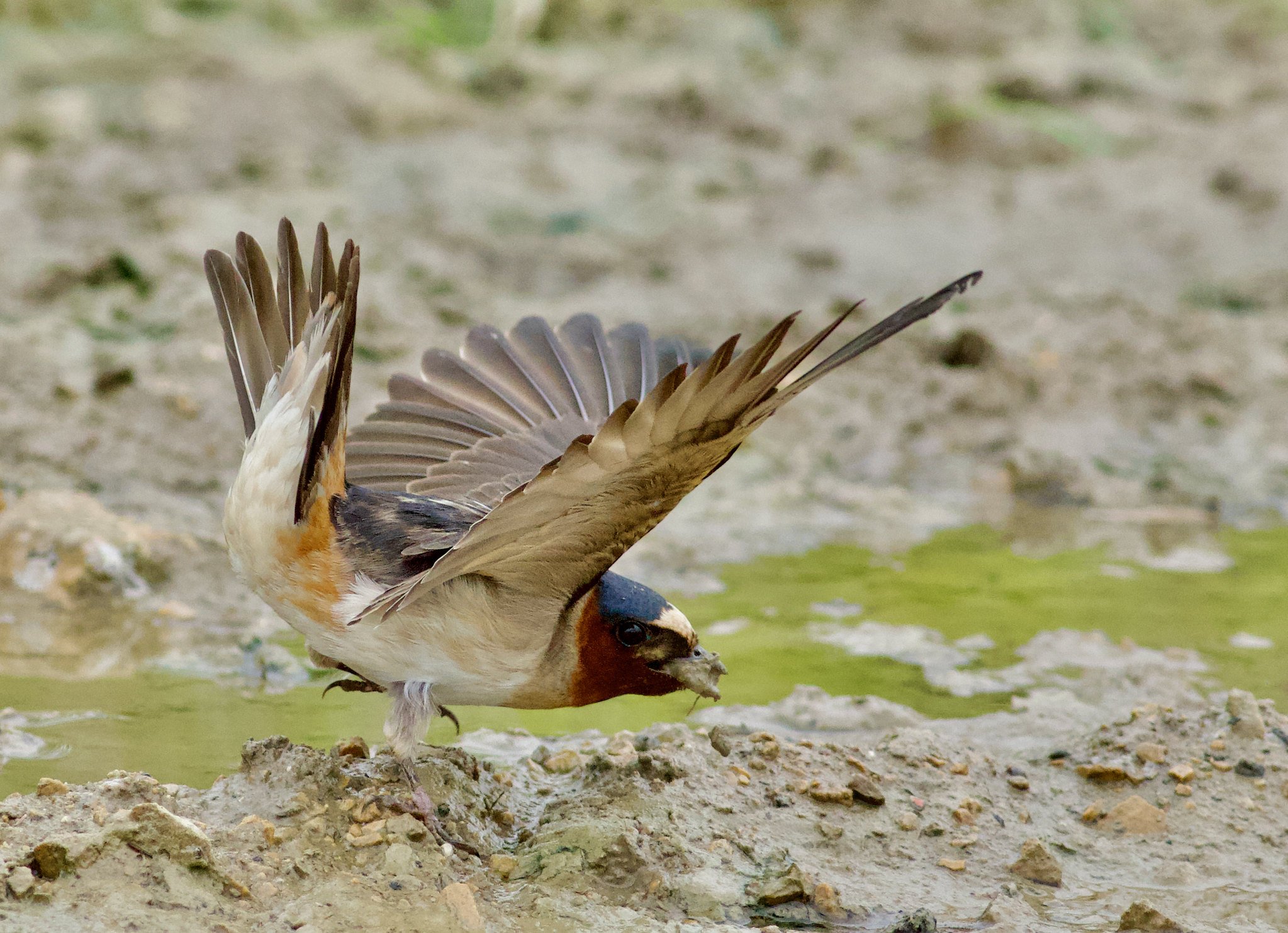Earthen dwellings have been constructed across cultures and around the world for thousands of years, and building them would have been an enormous task. They provided a much stronger level of protection from weather and enemies. This seems like quite a feat for low tech humans. But imagine building your house on a sheer cliff face… out of mud… with your mouth.
A Cliff Swallow gathers mud. Photo by Arlene Koziol
Cliff Swallows are a chatty bunch who form colonies much like their close relatives the Barn Swallow. They have similar brown, orange, and blue coloration, but adult Cliff Swallows have a prominent white dot on their forehead and lack the long outer tail feathers that are easily seen on Barn Swallows in flight. Barn Swallows originally nested in caves while cliff swallows utilized vertical cliff faces. Both species have taken readily to large human infrastructure, but barn swallows prefer large open buildings (yes, especially barns) and cliff swallows select bridges over water.
Cliff Swallow. Photo by Arlene Koziol
Barn Swallow. Photo by Kelly Colgan Azar
Cliff Swallow gathering mud for its nest. Photo by Arlene Koziol
Barn Swallow gathering mud for its nest. Photo by Arlene Koziol
Mike Mossman and Liza Hartman searched the Highway 12 and Highway 60 bridges out of Sauk City during the Wisconsin Breeding Bird Atlas II, finding at least 800 Cliff Swallow nests on each. These are excellent sites with favorable nest mounting surfaces and an abundance of insects who are attracted to or hatch out of the Wisconsin River. Mike wrote, “We count 800-1,000 Cliff Swallow nests under the Hwy 60 bridge, packed almost entirely on the southern, concrete surface. It looks like the surface might have been provided for them intentionally. The remaining surfaces of this bridge are steel I-beams and painted steel, which are not suitable for nest attachment, though a few nests are built on those surfaces where there is some bit of relief, such as where bolts protrude along joints. I have never seen more nests in a single colony, and so tightly and regularly packed… Marvelous.”
Cliff Swallow nests under a bridge. Photo by Joshua Mayer
Mark Martin discovered that some Amish folks call Cliff Swallows Eave Swallows because they can nest on the outside of buildings. Mark wrote, “The son erected two 2 x 4s - 16 feet long to the top of the barn across the road for 40 pairs of "Eave Swallows".
Goose Pond doesn’t have suitable bridges or eves on site, so why am I writing about them? After hearing the low whistle of a Purple Martin, uncommon at Goose Pond, I decided to start an eBird checklist. This prompted me to tally all of the bird species within sight or earshot. While I usually dismiss our swallow-filled power lines as being populated by Barn Swallows (some hundreds occupy our barn), I noticed many had a white spot on their forehead. In total there were 271 adult and juvenile Cliff Swallows. High counts are hard to come by with so many avid birders at Goose Pond, so I don’t get too hopeful. The highest count for Cliff Swallows was set in 2021 with 20 individuals. 20! I never would have noticed our flock if it wasn’t for the Purple Martin.
Birds are complex creatures with different needs throughout their life cycle. These Cliff Swallows were perched overlooking one of our constructed wetlands, the only place at Goose Pond where standing water remains. While we don’t fledge any Cliff Swallows from the sanctuary, we’re happy to provide a place where adults and their recently fledged young can socialize, feed, and rest.
Graham Steinhauer, Goose Pond Sanctuary land steward
Cover photo by Arlene Koziol











